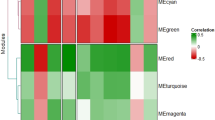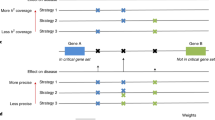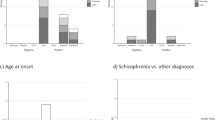Abstract
The genetic basis of complex diseases is expected to be highly heterogeneous, with many disease genes, where each gene by itself has only a small effect. Based on the nonlinear contributions of disease genes across the genome to complex diseases, we introduce the concept of single nucleotide polymorphism (SNP) synergistic blocks. A two-stage approach is applied to detect the genetic association of synergistic blocks with a disease. In the first stage, synergistic blocks associated with a complex disease are identified by clustering SNP patterns and choosing blocks within a cluster that minimize a diversity criterion. In the second stage, a logistic regression model is given for a synergistic block. Using simulated case–control data, we demonstrate that our method has reasonable power to identify gene–gene interactions. To further evaluate the performance of our method, we apply our method to 17 loci of four candidate genes for paranoid schizophrenia in a Chinese population. Five synergistic blocks are found to be associated with schizophrenia, three of which are negatively associated (odds ratio, OR < 0.3, P < 0.05), while the others are positively associated (OR > 2.0, P < 0.05). The mathematical models of these five synergistic blocks are presented. The results suggest that there may be interactive effects for schizophrenia among variants of the genes neuregulin 1 (NRG1, 8p22-p11), G72 (13q34), the regulator of G-protein signaling-4 (RGS4, 1q21-q22) and frizzled 3 (FZD3, 8p21). Using synergistic blocks, we can reduce the dimensionality in a multi-locus association analysis, and evaluate the sizes of interactive effects among multiple disease genes on complex phenotypes.
Similar content being viewed by others
Log in or create a free account to read this content
Gain free access to this article, as well as selected content from this journal and more on nature.com
or
References
Agresti A (1996) An introduction to categorical data analysis. Wiley, New York
Benjamini Y, Hochberg Y (1995) Controlling the false discovery rate: a practical and powerful approach to multiple testing. J R Stat Soc 57:289–300
Duda RO, Schafer DW (2001) Pattern classification. Wiley, New York
Frankel WN, Schork NJ (1996) Who’s afraid of epistasis? Nat Genet 14:371–373
Goldberg DE (eds) (1989) Genetic algorithms in search, optimization, and machine learning, vol 77. Addison-Wesley, New York
Goodman JE, Mechanic LE, Luke BT, Ambs S, Chanock S, Harris CC (2006) Exploring SNP–SNP interactions and colon cancer risk using polymorphism interaction analysis. Int J Cancer 118:1790–1797
Hahn LW, Ritchie MD, Moore JH (2003) Multifactor dimensionality reduction software for detecting gene–gene and gene–environment interactions. Bioinformatics 19:376–382
Harrison PJ, Owen MJ (2003) Genes for schizophrenia? recent findings and their pathophysiological implications. Lancet 361:317–319
Harrison PJ, Weinberger DR (2005) Schizophrenia genes, gene expression, and neuropathology: on the matter of their convergence. Mol Psychiatry 10:40–68
Hoh J, Ott J (2003) Mathematical multi-locus approaches to localizing complex human trait genes. Nat Rev Genet 4:701–709
Kang GL, Yue WH, Zhang JF, Cui YH, Zuo YJ, Zhang D (2008) An entropy-based approach for testing genetic epistasis underlying complex diseases. J Theor Biol 250:362–374
Kang GL, Zuo YJ (2007) Entropy-based joint analysis for two-stage genome-wide association studies. J Hum Genet 52:747–756
Onay VU, Briollais L, Knight JA, Shi E, Wang Y, Wells S et al (2006) SNP–SNP interactions in breast cancer susceptibility. BMC Cancer 6:114
Risch N, Merikangas K (1996) The future of genetic studies of complex human diseases. Science 273:1516–1517
Ritchie MD, Hahn LW, Moore JH (2003) Power of multifactor dimensionality reduction for detecting gene–gene interactions in the presence of genotyping error, missing data, phenocopy, and genetic heterogeneity. Genet Epidemiol 24:150–157
Ritchie MD, Hahn LW, Roodi N, Bailey LR, Dupont WD, Parl FF, Moore JH (2001) Multifactor-dimensionality reduction reveals high-order interactions among estrogen-metabolism genes in sporadic breast cancer. Am J Hum Genet 69:138–147
Seaman SR, Müller-Myhsok B (2005) Rapid simulation of p-values for product methods and multiple-testing adjustment in association studies. Am J Hum Genet 76:399–408
Yue WH, Kang GL, Zhang YB, Qu M, Tang FL, Han YH, Ruan Y, Lu TL, Zhang JF, Zhang D (2007) Association of DAOA polymorphisms with schizophrenia and clinical symptoms or therapeutic effects. Neurosci Lett 416:96–100
Yue WH, Liu ZH, Kang GL, Yan J, Tang FL, Ruan Y, Zhang JF, Zhang D (2006) Association of G72/G30 polymorphisms with early-onset and male schizophrenia. Neuroreport 17:1899–1902
Zhang YB, Yu X, Yuan YB, Ling YS, Ruan Y, Si TM, Lu TL, Wu SP, Gong XH, Zhu ZJ, Yang JZ, Wang F, Zhang D (2004) Positive association of the human Frizzled 3 (FZD3) gene haplotype with schizophrenia in Chinese Han population. Am J Med Genet 129B:16–19
Acknowledgments
We would like to thank the anonymous referees for very helpful comments on the early draft. This work was supported in part by grants from the National Natural Science Foundation of China (No. 30530290, 30400149, 60334040), the National High Technology Research and Development Program of China (No. 2006AA02Z195, 2007AA02Z423), The National Basic Research Program of China (No. 2007CB512301), The National Science Foundation of America (No. DMS 0234078), and the Strategic Partnership Grant of the Michigan Foundation.
Author information
Authors and Affiliations
Corresponding author
Additional information
Guolian Kang and Weihua Yue contributed equally to this work.
Rights and permissions
About this article
Cite this article
Kang, G., Yue, W., Zhang, J. et al. Two-stage designs to identify the effects of SNP combinations on complex diseases. J Hum Genet 53, 739–746 (2008). https://doi.org/10.1007/s10038-008-0307-x
Received:
Accepted:
Published:
Issue date:
DOI: https://doi.org/10.1007/s10038-008-0307-x



